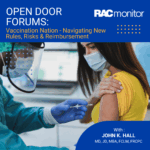
Compliance as a Revenue Strategy
Grab your pens, alert your billing teams, and cue up your electronic medical record (EMR) vendors, because the Centers for Medicare & Medicaid Services (CMS)

A listener, who is a risk adjustment program manager, asked me to elucidate when a congenital condition code is appropriate. She was most interested in the cardiac conditions in the context of pediatric patients, but I thought it would be useful to go over all the aspects.
Congenital means a patient is born with an anomaly, or abnormality. It can be a physical deformity or a genetic or chromosomal abnormality. This is in contradistinction to an acquired condition which means the patient was born intact, but something happened, either accidentally or intentionally, and there is now an abnormal condition.
A good example is Q71.21, Congenital absence of both forearm and hand, right upper limb, versus Z89.211, Acquired absence of right upper limb below elbow. The latter could be from a farming accident, for instance, or by surgical amputation for a malignancy. Additional codes might provide those etiologic details.
According to the Coding and Reporting Guidelines, similar to codes from Chapter 16, Certain Conditions Originating in the Perinatal Period (the P codes), codes from Chapter 17, Congenital malformations, deformations, and chromosomal abnormalities (Q codes), are permitted to be used throughout the life of the patient.
In the current state of technology, a patient who has Trisomy 21 will always have Trisomy 21 coded. I say, “in the current state,” because there are new gene therapies that can effectively cure a genetic disease, like cystic fibrosis or sickle cell disease, and it is not out of the realm of possibility that other genetic or even chromosomal abnormalities may be conquered in the future.
Let’s address the conditions which interested Mary, congenital heart disorders. A musculoskeletal abnormality like the one noted above may be permanent and ongoing, so it is understandable that the code applies for the patient’s entire life. There are conditions which might be amenable to surgery, might require multiple surgeries, but even with those interventions, the condition may not be completely eliminated. For instance, hypoplastic heart syndrome (e.g., Q22.6, Hypoplastic right heart syndrome) may require multiple surgeries, and it may be alleviated, but the heart may never be rendered normal. That patient would continue to have Q22.6 for the duration of their life.
There are congenital heart defects which are diagnosed very early on, like ventricular septal defect (VSD) or patent ductus arteriosus (PDA), which may resolve spontaneously and completely without any treatment (I call that, “tincture of time”). Once the condition has resolved, the code to represent that will be found in Z87.7-, Personal history of (corrected) congenital malformations.
The parenthetical, “corrected,” is where the nuance of diagnosis and coding falls. If the VSD is large and doesn’t close on its own, surgery might be necessary to accomplish the closure. If it is successful, and the VSD no longer exists and is no longer clinically relevant, then it is “corrected.” Z87.74, Personal history of (corrected) congenital malformations of heart and circulatory system, would apply.
If, however, a congenital condition has been addressed but not “corrected,” it should still be coded as being present. Providers don’t understand the concept of “history of” as it is defined in coding. “History of” means old, resolved, no longer active, not being treated, and no longer impacting the patient, but may have the potential for recurrence or may influence the provision of future care. Maybe having that congenital issue and the surgery to correct it might portend problems in the future, like a higher likelihood of development of heart failure. That is why knowing the patient had a personal history of the condition and its repair is clinically significant, and a Z code is appropriate.
When should a coder pick up the condition? When the provider (hopefully accurately) documents that the condition is still present. If they document “history of” and it isn’t clear to the coder whether it is “chronic condition of” or “resolved historical condition of,” a query is indicated. I strongly recommend ensuring that the provider understands the “history of” concept before they respond to a query.
For risk adjustment purposes, any year when the condition still is present, the diagnosis should be documented and the code picked up. The year following successful and complete repair, the provider should document that the condition was “corrected,” and the Z code would then be applicable.
So, for instance, if a patient undergoes a successful reconstruction in February, for that entire year for risk adjustment purposes, the Q code would continue to be valid although after the recovery period is complete, the Z code demonstrating “history of” would then be appropriate for that given encounter. The following January, there would no longer be risk adjustment as only the Z code would be captured in that calendar year.
Don’t continue to pick up Q codes just because they have risk adjustment implications. You may get a financial boost at the time, but the compliance jeopardy is just not worth the risk.
Programming note:
Listen to Dr. Erica Remer as she cohosts Talk Ten Tuesday with Chuck Buck, Tuesday, 10 Eastern.


Grab your pens, alert your billing teams, and cue up your electronic medical record (EMR) vendors, because the Centers for Medicare & Medicaid Services (CMS)

Gilead Sciences, Inc. has agreed to pay $202 million to settle allegations raised by whistleblower Dr. Paul Bellman that Gilead violated the False Claims Act
Please log in to your account to comment on this article.

Stop revenue leakage and boost hospital performance by mastering risk adjustment and HCCs. This essential webcast with expert Cheryl Ericson, RN, MS, CCDS, CDIP, will reveal how inaccurate patient acuity documentation leads to lost reimbursements through penalties from poor quality scores. Learn the critical differences between HCCs and traditional CCs/MCCs, adapt your CDI workflows, and ensure accurate payments in Medicare Advantage and value-based care models. Perfect for HIM leaders, coders, and CDI professionals. Don’t miss this chance to protect your hospital’s revenue and reputation!

Struggling with ICD-10-CM coding for diabetes and complications? This expert-led webcast clarifies complex combination codes, documentation gaps, and sequencing rules to reduce denials and ensure compliance. Dr. Angela Comfort will provide actionable strategies to accurately link diabetes to complications, improve provider documentation, and optimize reimbursement—helping coders, CDI specialists, and HIM leaders minimize audit risks and strengthen revenue integrity. Don’t miss this chance to master diabetes coding with real-world case studies, key takeaways, and live Q&A!

Uncover critical guidance. HIM coding expert, Kay Piper, RHIA, CDIP, CCS, provides an interactive review on important information in each of the AHA’s 2025 ICD-10-CM/PCS Quarterly Coding Clinics in easy-to-access on-demand webcasts, available shortly after each official publication.

Uncover critical guidance. Kay Piper provides an interactive review on coding guidelines and more in the AHA’s fourth quarter 2025 ICD-10-CM/PCS Coding Clinic in an easy to access on-demand webcast.

Bring your questions and join the conversation during this open forum series, live every Wednesday at 10 a.m. EST from June 11–July 30. Hosted by Chuck Buck, these fast-paced 30-minute sessions connect you directly with top healthcare experts tackling today’s most urgent compliance and policy issues.

Fraud convictions don’t just punish a few bad claims; they can wipe out years of reimbursements. Don’t wait for an audit to learn the rules. Join Frank Cohen, MPA, for a live Q&A on spotting red flags, avoiding liability, and protecting your practice. Register now and bring your questions!

Substance abuse is everywhere. It’s a complicated diagnosis with wide-ranging implications well beyond acute care. The face of addiction continues to change so it’s important to remember not just the addict but the spectrum of extended victims and the other social determinants and legal ramifications. Join John K. Hall, MD, JD, MBA, FCLM, FRCPC, for a critical Q&A on navigating substance abuse in 2025. Register today and be a part of the conversation!

Vaccine policies, billing rules, and compliance risks are changing fast! How will your organization adapt? Join John K. Hall, MD, JD, MBA, FCLM, FRCPC, for a critical Q&A on navigating new Medicare mandates, coding updates, and legal challenges in vaccination programs. Get expert answers on billing, compliance, outbreak risks, and operational strategies to protect your facility and patients. . Join us live and bring your questions to the table.
Prepare for the 2025 CMS IPPS Final Rule with ICD10monitor’s IPPSPalooza! Click HERE to learn more
Get 15% OFF on all educational webcasts at ICD10monitor with code JULYFOURTH24 until July 4, 2024—start learning today!
CYBER WEEK IS HERE! Don’t miss your chance to get 20% off now until Dec. 2 with code CYBER24